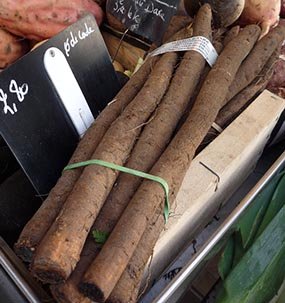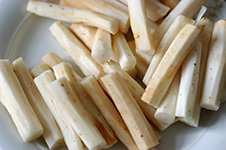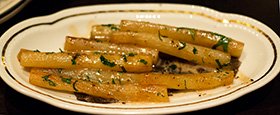Salsify Nutrition facts
Salsify, also known as the vegetable oyster, is a kind of saltwater-mollusk flavored root vegetable of Mediterranean origin. Salsify and Scorzonera are two closely related plants in the Asteraceae family.
They are hardy perennials native to Southern Europe, cultivated for their delicious edible taproots. Of the two species, Scorzonera (black oyster plant), however, is more popular than common or white-salsify, especially in Spain, Italy, and Belgium.
Scientific name:- 1. Common Salsify: Tragopogon porrifolius. 2. Spanish or black salsify: Scorzonera hispanica. Both have similar growth characteristics as that of other Apiaceae family members like carrots, parsley, celery, etc.
 |
| Black salsify. Note for long, linear black taproots. Courtesy: beck |
Both scorzonera and white salsify are hardy perennials growing best in the cold temperate regions. The plant reaches about 2-3 feet in height, and if left to grow further, it blooms yellow flowers and seed pods during the second year.
The root grows about 12 to 16 inches below the soil and features thick bark-like skin and sticky, white firm-textured flesh underneath. It takes about 120 days for the crop to dugout its roots. In general, seeds are sown in summer to harvest in winter or fall for harvesting in spring.
Scorzonera, also known as black-salsify, features pointed leaves. It is commonly cultivated in Spain and Belgium for its long, black, straight, and stout underground taproots.
Common Salsify, also known as light colored salsify, features long, linear leaves. It is found commonly in Russia, France, and Italy.
As in parsnips, oyster plants also require adequate exposure to winter frost for good crop production. Frosting facilitates the conversion of much of its starch into sugars in the taproots and helps develop long, narrow, and firm taproots.
The roots normally are harvested when they reach about ten to twelve inches in length, by pulling the entire plant along with its root (uprooting) as in carrots.
8 Amazing Health Benefits of Salsify (Vegetable-Oyster plant)
Salsify roots carry 82 calories per 100 grams, almost as that of in sweet potatoes. Nonetheless, its root is rich in several health-benefiting phytonutrients, inulin, vitamins, and minerals.
It is one of the excellent sources of soluble and insoluble dietary fiber. Inulin (not insulin) is a natural, soluble inert complex polysaccharide present in salsify roots.
Inulin acts as a prebiotic, helps absorb minerals and regulate blood sugar levels, controls obesity, and eases constipation problems.
As in other members of Apiaceae family vegetables, vegetable oyster too contains many poly-acetylene antioxidants such as falcarinol, falcarindiol, panaxydiol, and methyl-falcarindiol.
Several research studies from scientists at the University of Newcastle upon Tyne found that these compounds possess anti-inflammatory, antifungal, and anti-cancer function and offer protection from colon cancer and acute lymphoblastic leukemia (ALL).
Fresh roots are also good in vitamin-C; provide about 8 mg or 13% of RDA. Vitamin C is a powerful water-soluble antioxidant, readily available to us from natural sources. It helps the human body maintain healthy connective tissue, teeth, and gum. Its anti-oxidant property helps protect from diseases and cancers by scavenging harmful free radicals from the body.
Further, the root is rich in many B-complex groups of vitamins such as folates, vitamin B-6 (pyridoxine), thiamin, and pantothenic acid.
Besides, it also has healthy levels of minerals like iron, calcium, copper, potassium, manganese, and phosphorus. Potassium is an important component of cells and body fluids that helps control heart rate and blood pressure by countering the effects of sodium.
| Principle | Nutrient Value | Percent of RDA |
|---|---|---|
| Energy | 82 Kcal | 4% |
| Carbohydrates | 18.60 g | 14% |
| Protein | 3.30 g | 6% |
| Total Fat | 0.20 g | 1% |
| Cholesterol | 0 mg | 0% |
| Dietary Fiber | 3.3 g | 9% |
| Vitamins | ||
| Folates | 26 µg | 6.5% |
| Niacin | 0.500 mg | 3% |
| Pantothenic acid | 0.371 mg | 7% |
| Pyridoxine | 0.277 mg | 2% |
| Riboflavin | 0.220 mg | 18% |
| Thiamin | 0.080 mg | 7% |
| Vitamin A | 0 IU | 0% |
| Vitamin C | 8 mg | 13% | Electrolytes |
| Sodium | 20 mg | 1% |
| Potassium | 380 mg | 8% |
| Minerals | ||
| Calcium | 60 mg | 6% |
| Copper | 0.089 mg | 9% |
| Iron | 0.70 mg | 9% |
| Magnesium | 23 mg | 6% |
| Manganese | 0.268 mg | 12% |
| Phosphorus | 75 mg | 11% |
| Selenium | 0.8 µg | 1% |
| Zinc | 0.38 mg | 3% |
Selection and storage
Inside the US, fresh salsify can occasionally be found in some supermarkets. Each season, many enthusiastic home gardeners instead grow them in their backyard for fresh produce. If you are the one, then harvesting the root is quite a tricky game than growing salsify itself. Their long, slender taproots tend to snap and spoil easily. Dig the earth around the root and gently pull the entire plant along with the root. Snapped root should be used early, or else it tends to lose its flavor early.
Fresh roots stay well inside the refrigerator for up to 7-10 days. Farmers left the entire root buried under the soil throughout winter since exposure to frosting enhances its flavor and makes it appetizing.
In the markets, select fresh, firm, and square roots. Avoid soft, shriveled, pitted, knobby, or damaged roots.
Prepared and canned salsify, however, does not carry the same intense oyster flavor as fresh ones.
Preparation and serving methods
 |
| Prepared scorzonera chunks. Photo courtesy: Steffen zahn. |
Preparing salsify roots can be tedious but worth exploring. In general, its outer skin should be removed before being employed in the dishes. Give gentle scrub wash in cold water. Trim the ends. Peel its skin using a paring knife to expose white edible flesh inside.
Peeling results in the oozing of sticky latex from its surface which can stain hands and clothes. You might need a pair of gloves and a soft cloth to clean the peeled root surface. Rinse the peeled root inside acidulated water (vinegar/lemon juice) in order to prevent it from turning brown. Peeling can be easier in boiled roots.
Cook briefly; overcooking turns the flesh mushy.
Here are some serving tips:

|
| Baked black vegetable oyster root served with shaved truffles. Photo: krista |
Prepared, raw, vegetable oysters can add a unique, sweet flavor to salads, coleslaw, and toppings.
Black salsify is a prized delicacy in some traditional Italian dishes. Sliced/diced it can be added to stews, soups, or mashed (pureed) like parsnips.
Its prepared roots can be roasted, boiled, or steamed like asparagus shoots.
Slices and cubes added to stews, soups, and stir-fries and served with poultry, fish, and meat.
It can be used in bread, pies, casseroles, cakes, etc., in a variety of savory dishes.
Safety profile
Excess consumption of salsify root in food may cause stomachache, bloating, abdominal discomfort, and diarrhea. Inulin also elicits hypersensitivity reactions, itching, and redness in some sensitive persons.
Being a member of the carrot family vegetables, salsify may elicit hypersensitivity reactions like contact dermatitis and oral allergy syndrome (OAS). Individuals with a known history of allergy to these taproots should avoid them. (Medical disclaimer).
≺≺ Back to Vegetables from Salsify. Visit here for an impressive list of vegetables with complete illustrations of their nutrition facts and health benefits.
≺≺ Back to Home page.
Further reading:
Refer Stanford School of Medicine Cancer information Page- Nutrition to Reduce Cancer Risk.